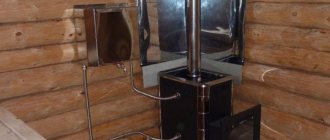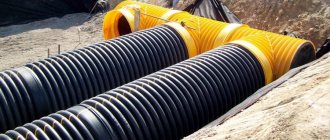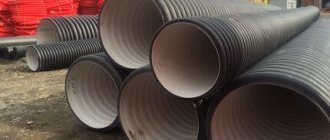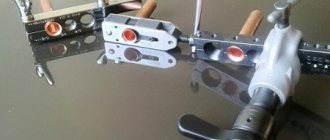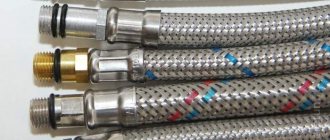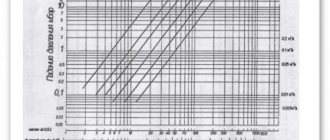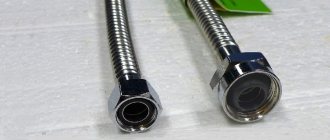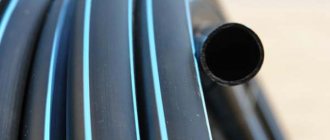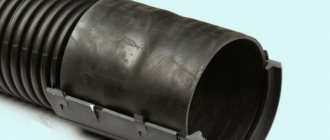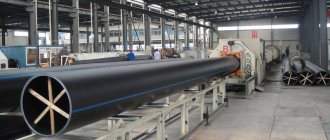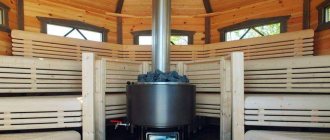Hello, friends!
The topic of today's article is corrugated stainless pipe. This is a relatively new structural element designed for arranging various communications. First appeared in Japan in the 1980s of the 20th century.
The Land of the Rising Sun is known for constant earthquakes and terrible tsunamis. Therefore, Japanese designers are constantly developing engineering solutions that are resistant to seismic loads. A corrugated stainless steel pipe is a clear example of such a solution.
From Japan, the product entered the construction markets of other countries and became widespread. And I’ll tell you why now.
What is it and where is it used?
Corrugated steel pipe is a long hollow cylinder of steel with a variable cross-section, resembling an accordion in appearance. Its uniqueness lies in the combination of the strength of metal with the flexibility of rubber.
In less than forty years of existence, the product has gained enormous popularity in construction, manufacturing and agriculture.
Corrugated stainless steel is used in the construction of the following systems:
- Heating;
- Gas supply;
- Water supply;
- Conditioning;
- Firefighting;
- Warm floor;
- Pipelines for various fuels and lubricants;
- Electrical networks - usually as a protective corrugation for cables.
How to make a corrugated pipe from stainless steel
The raw material for the product is usually AISI 304 sheets. This material is similar to domestic stainless steel 12×18n9. Due to the high content of alloying elements, including nickel, the material is durable, corrosion-resistant and is not afraid of temperature changes (from -50 o C to +110 o C).
Pipe manufacturing occurs in several stages:
- The metal strip is fed into special machines that form it into a cylindrical blank;
- The workpiece is welded in a gas environment;
- The rollers form a steel corrugation;
- The product undergoes heat treatment to impart the necessary flexibility;
- The finished pipe is checked for the presence of microcracks and the quality of the weld. Control takes place in a liquid environment under pressure;
- The pipe is cut and rolled into coils.
A mandatory procedure after completing all technological operations is quality control of the finished product. At this stage, it is tested under pressure - placed in a liquid medium and monitored for the presence of microcracks in the walls.
Production technology
Such products are manufactured on automated lines. The “human factor” is practically absent, which allows you to perform basic technological operations with a high degree of accuracy. The products of Japanese manufacturers are considered the most reliable, however, according to the Price/Quality criterion, Latvian goods “breathe in their backs”.
Let's take a closer look at the basic stages of producing stainless corrugated pipes for water supply.
- First, the steel strip undergoes pre-treatment. It is then fed to the molding line. There the tape is bent and turned into a cylindrical blank;
- then the main joint is welded automatically in a special environment of inert gases;
- then the smooth-walled billet is rolled. For this, parts of different diameters are used. The result is a corrugated stainless steel pipe;
- At the final stage, the material is cut into measured pieces, the length of which does not exceed 50 meters. For ease of transportation and installation work, individual segments are wound into coils.
The pitch of the depressions and protrusions of the corrugation may differ, since different manufacturers are guided by their own Technical Conditions and Standards. However, the quality of the final product does not suffer from this.
To obtain a corrugated pipe, a steel billet is passed through special rollers
Advantages and disadvantages
I propose to figure out why corrugated stainless steel pipes are so popular in the domestic market. Let's look at the advantages and disadvantages in detail.
Pros:
- Flexibility. The element can be bent without damage. This allows you to use a minimum number of fittings during installation and install the product in hard-to-reach places. The pipe bends easily by hand;
- Strength. Unlike plastic, a metal flexible pipe does not lose its cross-sectional geometry when compressed and can withstand water hammer and high pressure;
- Aesthetics. The design does not need to be painted or hidden - it is elegant and visually attractive;
- High resistance to temperature changes. It should be noted here that the material can withstand up to 40 freezing cycles, after which damage to the macrostructure is still possible. The product is not sensitive to high temperatures;
- Length. Sometimes an engineering solution requires laying long-distance communications (warm floors, walls). Stainless steel corrugation will allow you to install long sections of pipeline without additional fittings;
- Corrosion resistance. This is especially important when working in basements, damp rooms, when installing communications under the plaster layer, in grooves, behind decorative panels.
- Immunity to vibrations and other mechanical loads;
- Smoothness of the inner walls;
- Reliability and durability.
Manufacturers set service life limits only for fittings.
- Small weight of 1 linear meter;
- The pipe is not counterfeited; it is still difficult to find a product made from cheap, low-quality stainless steel. Unfortunately, as you understand, the key word in this phrase is “yet.”
Minuses:
- Brass fittings that fasten pipes together require regular maintenance (checking tightness, tightening, replacing liners);
- The appearance will not fit harmoniously into every room;
- Low level of resistance to some chemical elements;
- Dust constantly accumulates in the folds of the corrugation;
- Electrical conductivity. In some systems (warm floors, walls, etc.) stray currents occur. To prevent emergency situations, grounding and dielectric gaskets are necessary;
- High heat transfer coefficient. Complicates the use of products in unheated rooms. The problem is solved by a layer of insulation;
- Inability to use for sewer networks;
- High price.
Product characteristics
Corrugated stainless steel pipe has the following characteristics:
- Dimensions. Standard indicators for the internal diameter of the product are 15, 20, 25 and 32 mm. Products with larger diameters are available to order. The process of their production does not present any particular difficulties.
- Operating temperature range. The product can be used at temperatures ranging from -50...+800°C. The flexibility of the pipe, which is made of stainless steel, is maintained at -40°C. When using plastic fittings, the upper temperature of the water released through the pipes is limited to +110°C. Otherwise, the parts will melt. A short-term increase in temperature up to +150°C is allowed
- Flexibility. You can bend a water pipe in different ways, but you cannot exceed the maximum permissible bend value, equal to three times the diameter.
- Impact resistance. The pipe is resistant to high pressure and mechanical damage, so it can be used in any conditions. The product can operate at a pressure of 50 atm. The material can withstand short-term increases in the indicator up to 200 atm.
- Oxygen impermeability. This figure is close to 100%
- Roughness coefficient. The maximum value is 0.008.
- Life time. Manufacturers claim that with proper installation and use, the pipe will last at least 20 years. In our country, products began to be used no more than 10 years ago, so this statement has not been verified in practice.
Types and features
There are two types of corrugated stainless steel pipes:
- Annealed;
- Not annealed.
Annealed products undergo additional heat treatment during the manufacturing process. Annealing gives the metal additional flexibility and softness.
Annealed products are often used in structures with a large number of bends.
The advantage of non-annealed material is its cost. The difference in price is up to 30%, and if there is no need to install complex communication routes, there is no point in overpaying.
Which pipe to choose for:
- Heating
For heating networks, it is necessary to choose a pipe with a diameter of 15 to 50 mm with a nominal pressure of up to 15 Bar. If the heating system is straight, then a non-annealed pipe will do. If you plan to bend a radiator from corrugation, you should choose an annealed product.
- Water supply
Metal corrugated culverts have an average diameter of 20-25 mm, must withstand pressure up to 15 Bar and temperature up to 110 degrees Celsius.
- Electrical wiring
To protect electrical wiring, the smallest diameter of 12mm is also suitable. Technical characteristics do not play a special role, but you should pay attention to the route of wiring. For multiple bends, an annealed element should be selected.
- Gas pipeline
The gas pipe must have a minimum diameter of 15mm. When choosing a gas pipe, you must pay attention to the quality of the surface of the product - even the slightest flaws are not allowed.
Requirements for installing smoke exhaust ducts
When installing flexible chimneys, it is necessary to comply with some important requirements that will ensure reliable and efficient operation of the channel. Among them are:
- performing fastening using an adapter;
- correspondence of the diameter of the smoke exhaust duct to the cross-section of the outlet opening of a particular heating device;
- placing the corrugated pipe in a fireproof case when passing through the interfloor ceiling;
- ensuring double thickness of the walls of the outer protective casing in order to ensure the safety of the structure in case of possible damage to the outer layer;
- hermetically sealing the corrugated pipe to the heating system, preventing gas leaks;
- the length of the channel section from the bottom of the pipe to the horizontal section of the flexible chimney is not less than 50 cm;
- ensuring the radius of curvature of the installation of a corrugated pipe is not less than its diameter;
- the distance from the wall or ceiling to the connecting pipe is not less than 50 mm if they are made of non-combustible material;
- if the wall is made of another material, this distance must be at least 250 mm;
- providing a vertical connection to the boiler;
- the total length of the installed horizontal sections is no more than three meters;
- installation of a flexible chimney with a slope towards gas equipment of more than 0.01 degrees.
All materials used to secure the pipe and come into contact with it must be non-flammable
Manufacturers and what to look for when purchasing
As mentioned above, the first stainless corrugated pipes were produced in Japan. But at the moment, other countries have also entered the ranking of leaders in product manufacturing.
The price largely depends on the manufacturer. Let's look at the most famous brands.
KOFULSO
Products of a South Korean company. It is distinguished by its variety of shapes, versatility, ability to withstand temperature changes and high water pressure. Available in both annealed and non-annealed versions in coils of 10-50 m. Diameters - from 15 to 50mm. The price varies from 140 to 2500 rubles/m.
NEPTUN
manufactures corrugated stainless steel pipes with a diameter of 15 to 32 mm. The products are corrosion-resistant, universal, suitable for gas pipelines, water pipes, heating elements, and heating boiler piping. They have high heat transfer. Price – from 85 to 700 rubles/m;
LAVITA
Another South Korean manufacturer. The pipes can withstand water pressure and water hammer perfectly and are suitable for installing water supply systems and other systems. Easy to install, durable. They are produced in annealed, unannealed form, as well as in a shell. The price ranges from 103 to 1050 rubles/m. Diameter – from 8 to 50mm.
НYDROSTA
And again South Korea. The company has developed a special steel polish that prevents the formation of deposits and deposits. Suitable for all plumbing systems except sewerage. The diameter of corrugated pipes is from 12 to 50 mm, the price is from 125 to 1500 rubles/m.
INOFLEX
The German company MEIBES produces corrugated metal pipes with a diameter of 12 to 40 mm. The products can withstand temperatures up to 200 degrees and pressures up to 16 Bar. Supplied in coils from 20 to 80 m. The price of one meter is from 650 to 2000 rubles.
When choosing pipes, pay attention to the following nuances:
- There should be no mechanical damage, creases, cracks, or burrs on the pipe;
- The corrugation pitch must be uniform;
- Steel grade – AISI (SUS) 304. I do not recommend purchasing AISI201, AISI409, AISI430 grades; in fact, this is ordinary shiny iron with a minimum amount of alloying additives;
- Connection fittings must be sold assembled;
Dimensions and approximate prices
We will summarize all sizes, designations, properties and characteristics into a single table.
| Nominal diameter | 8A | 12A | 15A | 18A | 20A | 25A | 32A | 40A | 50A |
| External diameter | 12.8 | 16.2 | 18.1 | 20.3 | 25.6 | 32 | 37.6 | 48 | 59.8 |
| Inner diameter | 9.7 | 12.7 | 14.1 | 16.5 | 21.1 | 27 | 32.1 | 42 | 53.5 |
| Wall thickness | 0.3 (0.25) | 0.3 (0.25) | 0.3 (0.25) | 0.3 (0.25) | 0.3 (0.25) | 0.3 (0.25) | 0.3 (0.25) | 0.4 (0.3) | 0.4 (0.3) |
| Number of pipe folds per 100mm | At least 25 | At least 24 | At least 23 | At least 21 | At least 19 | At least 18 | At least 18 | At least 14 | At least 13 |
| Minimum bend radius, mm | Up to 20 | Up to 30 | Up to 30 | Up to 40 | Up to 40 | Up to 50 | Up to 80 | Up to 120 | Up to 150 |
| Standard length, m | 60 | 60 | 50 | 40 | 30 | 30 | 20 | 10 | 10 |
| Recommended operating pressure, Bar | 17 | 15 | 13 | 12 | 12 | 10 | 8 | 3 | 2 |
Installation
Installation of pipes to other devices (mixers, taps, etc.) is done using brass fittings. Fittings are connected to equipment using rubber or polymer gaskets.
Connection methods:
- First of all, you need to purchase a special tool - a pipe cutter. The standard one is designed for diameters 15, 20, 25mm. We should not replace the pipe cutter with a grinder; we need an even cut. All burrs must be removed;
- Before installing the pipe, make sure that the union nut on the corrugation connection side is not tightened;
- The end of the pipe is inserted into the brass fitting until it stops, the nut is tightened;
- The pipeline is given the desired shape;
- After installation is completed, the system is tested using pressurized water. If a leak is detected, the union nuts should be tightened;
- Make sure that there is no kinking of the pipe during installation.
When connecting smooth and corrugated pipes, the fitting is first fixed on a regular part, then the corrugation is mounted.
Step-by-step process for installing a gas corrugated pipe
It is recommended to start installation with a tool kit. This set, however, is almost always available in any household, perhaps with the exception of one tool.
A typical set of tools required to carry out work aimed at laying a domestic gas line from flexible corrugated stainless steel tubes. The complete list for the work is as follows:
- Pipe cutter
- Bench knife.
- Pliers.
- Adjustable wrench (2 pieces).
- Workwear.
Pipe support is provided in a working manner using:
- pipe straps,
- ribbons,
- pendants,
tubes of suitable size and weight, at intervals not exceeding 1.2 - 2.5 meters.
Step #1: Trimming the Material to Length
Using a special pipe cutter, the material is cut to the installation size.
Cut the tube to the desired length using a pipe cutter. The cut must be made in the center of the base of the corrugation. Apply light pressure from the pipe cutter roller with additional rotations in one direction to maintain the roundness of the tube and eliminate burrs on the cut. All cuts are made on a straight section of pipe.
Note: The ends of the tubes are sharp, be careful when handling.
Step #2: Removing part of the polymer casing
Approximately this is how the end stripping of the tube from the protective casing material should be performed, exposing clean corrugated metal for work. Use a
utility knife to cut off part of the plastic coating. Cut the coating casing in such a way as not to clog the end of the steel tube with material. Remove the shortened portion of the shirt, exposing one full, wavy cavity of the tube.
Step #3: Installing the Nut on the Corrugated Tube
Installing the flange nut on the prepared section of the corrugated gas pipe
Place the flange nut on the pipe so that the threaded end is directed towards the end of the pipe. The flange of the nut must cover the yellow protective casing of the tube.
Step #4: Preparing the Retaining Ring
Placing a locking ring on the body of a flexible corrugated tube and crimping using pliers
Place the locking ring in the first cavity of the corrugation. Be careful not to create dents from friction. Squeeze the ring with pliers, applying light pressure over the entire area (360º) around the ring. As a result, obtain a tightly fitting element to the metal of the corrugation.
Step #5: Attaching the counter fitting to the gas system location
The counter part of the male fitting is installed at the place where the pipe connection is organized.
Make sure that the gasket inside the counter fitting is securely fastened in the socket. Apply pipe sealant to the tapered threads of the counter fitting and install this connection into the gas system.
Step #6: Final assembly of the system node
Final fastening of all fitting elements using a pair of wrenches
Place the flange nut on the installed fitting. Hand tighten the fitting assembly from the end of the nut, making sure that only the nut rotates (the fitting and gas line do not rotate).
Tighten to the recommended torque value shown in the table below, using a second wrench to secure the fitting in place (usually tighten firmly until the nut stops turning). Do not use sealant on the parallel threads (gasket side) of the socket.
Table of recommended torque values:
| Corrugated pipe size, mm | Torque value, Nm |
| 12,7 | 84 |
| 19,0 | 84 |
| 25,4 | 100 |
With the help of information: Gastite
Tags: gas innovative technologies plastic construction pipe pipeline
BRIEFING
Zetsila - publication of materials that are interesting and useful for society. News of technologies, research, experiments on a global scale. Social multi-thematic information - media .
Reviews and operating experience
Corrugated metal pipe is a relatively new product. From the forums studied by household users and specialists, one thing is clear - the main complaints are increased resistance to water flow (compared to a smooth pipe) and noise. However, none of the users noted the need to install additional circulation pumps.
There are often recommendations indicating the need to check pipe connections under high-temperature operating conditions. Gaskets usually become stiff under such conditions.
As an example, here are a few real reviews:
“….I put it on both CB and IR…no problems…manufacturers also have tests here at the testing site…compared to plastics, gn (corrugated stainless steel) is better just in terms of temperature…about scale…I don’t know…the only negative is the high price… »
“The most important drawback of corrugated stainless steel in central heating risers is noise, especially in a single-pipe system, and if this is not a radiator connection, but actually a riser across several apartments, the noise is noticeable and continuous...”
“...for example, heated floors are better than metal corrugation...it can be bent several times....”
To complete the picture, a little more time needs to pass.
Some useful tips from the experience of specialists:
- Do not install a stainless pipe with a fitting that is susceptible to corrosion;
- If a fitting with a supply pipe is installed on a ferrous metal pipe, be sure to install water filters;
- In a floor heating system, installation is carried out only in whole sections, additional connections are not allowed;
- The less bending and straightening, the longer the pipe lives
Pros and cons of corrugation
The corrugated pipe is suitable for any smoke exhaust systems, even at very high flue gas temperatures.
Another advantage of a corrugated pipe is the ease of connecting two sections together
It is resistant to:
- humidity;
- high temperatures;
- chemically aggressive environments.
This pipe is used not only for the chimney, but also in air conditioning and ventilation systems. Its flexibility allows you to easily install a chimney in the presence of complex architectural structures: sloped ceilings, floor beams, built-in columns, etc. This feature of stainless chimney corrugations reduces the cost and complexity of installation work.
Installation does not require expensive components (adapters, angles, elbows); this is important if the budget is limited. Among other advantages, we can note the possibility of connecting pipes of different diameters into one design. For this, special adapters are used.
Corrugated pipes have few disadvantages: short service life and the need for insulation to combat the formation of condensation. In addition, the draft in a corrugated pipe is much lower than in a smooth pipe, so it is not recommended to make a vertical channel along the entire length from such a product.
The diameter of the boiler pipe must match the size of the pipe being installed
Summarize
Corrugated stainless steel pipe is a relatively new, and according to manufacturers, if used correctly, it is an almost eternal invention.
There is not much experience in use yet; time will tell what can be improved in the technical characteristics of the corrugation.
And I say goodbye for today, and as always, I invite you to join us on social networks. It’s very convenient to share skills, track news and ask questions. We are waiting for your videos and reviews!
(
3 ratings, average: 5.00 out of 5)
Interstate standards
The requirements for corrugated products for water supply, gas pipelines and other communication networks are specified in paragraphs of GOST 10705-80, which contain information regarding electric welded steel elements.
To determine the quality of products, several samples are selected from a batch of manufactured products, which are then subjected to a series of tests.
Important! Quality control of the joint necessarily involves additional testing with hydraulic pressure.
As for the impact strength test, only three templates are taken. If we are talking about the chemical composition of raw materials - steel - then it is, first of all, determined by the standards of GOST 22536.0.
The production of annealed corrugated stainless steel pipes is carried out in accordance with other standards. Manufacturers should be guided by clauses of GOST 9941-81, which mention information on heat-deformed seamless products.
The main regulatory document in this area, adopted by the International Organization for Standardization, is the ISO 10806 standard, dating back to 2003.
